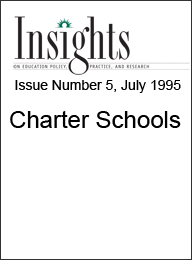Systemwide Improvement
Concerns remain about whether or not charter schools will actually have a positive impact on the broader public education system. Advocates believe that charter schools will act as a catalyst for systemwide educational improvement by serving as models of innovation and by introducing competition into the education marketplace. Two questions, however, remain unresolved. First, are the innovative educational strategies employed by charter schools being documented and transmitted to other schools? Second, are charter schools and other district schools in a fair and equitable competition?
Innovation
Although it has been limited, charter schools have initiated some broader changes throughout local districts. In Minnesota, a district chose to include a Montessori school as a district option instead of granting the school charter status. In California, a small number of sponsoring districts reported liberalizing school restructuring policies as a result of charter schools. In addition, a quarter of the districts were encouraging other schools to adopt some of the practices being used in charter schools (Dianda & Corwin, 1994).
The effects of particular charter school provisions and policies clearly represent a valuable source of information for all schools. Tracking and monitoring policy waivers, particularly in states like Colorado where exemptions are granted on a rule-by-rule basis, could provide important information about how policies can be successfully modified for other public schools (Huston et al., 1995). Few states, however, have established guidelines for monitoring whether or not specific charter school provisions are having a positive effect. Moreover, innovative teaching and learning strategies could also prove useful to more traditional public schools. Without careful collection and dissemination, the impact of charter schools on more traditional public schools could remain marginal.
Competition
While advocates insist that charter schools will introduce badly needed market incentives into a public system that has, thus far, not had to compete for students, some critics question whether charter schools and other public schools are competing on a level playing field.
While some charter schools retain the right to establish admissions criteria, traditional public schools have few choices about which students they serve. Moreover, charter schools, by their very nature, are able to circumvent rules and regulations concerning the provision of services (i.e., school lunches, transportation) that other public schools cannot. The ability to target specific student populations and choose the services they will provide for these students could place charter schools at a distinct advantage over more traditional public schools that must provide a large array of services to meet the needs of a diverse student population. Finally, many charter school may retain an advantage by relying on their host district for a number of administrative services. As a result, charters are able to cut costs and redirect critical resources into curriculum and instruction in ways that traditional schools cannot (Huston et al., 1995).
Next Page: Policy Implications

